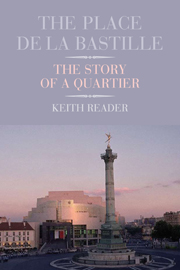Book contents
- Frontmatter
- Contents
- Acknowledgements
- Map by Stephen Ramsay Cartography
- Introduction: The Place de la Bastille
- 1 ‘What's that poor creature doing here?’: the area and the fortress before the Revolution of 1789
- 2 ‘Thought blew the Bastille apart’: the fall of the fortress and the revolutionary years, 1789–1815
- 3 ‘The strategy of the generals of Africa shattered’: the Restoration, Orleanist and Second Republic Years, 1815–1851
- 4 ‘Where is the noise of the storm that I love?’: The Second Empire from Haussmann to the Commune
- 5 ‘Satan's bagpipes’: La Belle Époque's forty-three years of peace
- 6 ‘Villains, stars and everybody in between’: The First War and the entre-deux-guerres
- 7 ‘Slicked hair and splendid sideburns’: Occupation and Liberation
- 8 ‘Let's have some sun!’: post-Gaullism and the Mitterrand years
- 9 ‘A building, not a monument’: the construction of the Bastille Opéra
- 10 ‘A real earthquake’: the impact of the Opéra on the quartier
- 11 Flânerie in the archive: the Faubourg/Bastille today
- Notes
- Bibliography
- Index
8 - ‘Let's have some sun!’: post-Gaullism and the Mitterrand years
- Frontmatter
- Contents
- Acknowledgements
- Map by Stephen Ramsay Cartography
- Introduction: The Place de la Bastille
- 1 ‘What's that poor creature doing here?’: the area and the fortress before the Revolution of 1789
- 2 ‘Thought blew the Bastille apart’: the fall of the fortress and the revolutionary years, 1789–1815
- 3 ‘The strategy of the generals of Africa shattered’: the Restoration, Orleanist and Second Republic Years, 1815–1851
- 4 ‘Where is the noise of the storm that I love?’: The Second Empire from Haussmann to the Commune
- 5 ‘Satan's bagpipes’: La Belle Époque's forty-three years of peace
- 6 ‘Villains, stars and everybody in between’: The First War and the entre-deux-guerres
- 7 ‘Slicked hair and splendid sideburns’: Occupation and Liberation
- 8 ‘Let's have some sun!’: post-Gaullism and the Mitterrand years
- 9 ‘A building, not a monument’: the construction of the Bastille Opéra
- 10 ‘A real earthquake’: the impact of the Opéra on the quartier
- 11 Flânerie in the archive: the Faubourg/Bastille today
- Notes
- Bibliography
- Index
Summary
The modernization of Paris went on apace during the presidency of de Gaulle's successor, Georges Pompidou (1969–74). This period saw grandiose modernization projects, many though not all reviled by defenders of traditional Paris: the destruction of the main Paris market at Les Halles, replaced by an underground shopping-mall, the building of the skyscraper Tour Montparnasse, next to and overshadowing the new rail station of the same name, and, less infelicitously, the construction of the Centre Beaubourg (renamed Centre Georges Pompidou after his death and opened in 1977). ‘Beaubourg’ is a major cultural centre housing an immense public library – now rather upstaged by the Bibliothèque Nationale de France on the Left Bank – Europe's largest museum of modern art, two cinemas and, in an annexe, the centre for musical technology IRCAM. Its planning and execution marked the first step in the growing cultural prominence of the Right Bank over the past thirty-five or so years, of which the Bastille Opéra and consequent changes in the area are the most recent example.
Pompidolian modernization had little direct effect on the Faubourg / Bastille – I use a compound form the better to emphasize the hybrid nature of the area at this time – though things might have been very different had the plan to honeycomb the city with high-speed urban expressways been fully realized. One of these – the radiale de Bagnolet – was to have cut a swathe through the 20th and 11th arrondissements, complete with a flyover in the boulevard de Charonne, near Nation.
- Type
- Chapter
- Information
- The Place de la BastilleThe Story of a Quartier, pp. 121 - 129Publisher: Liverpool University PressPrint publication year: 2011



